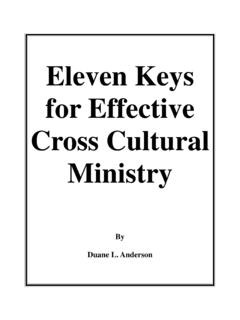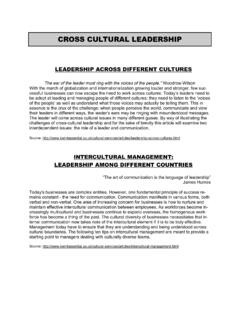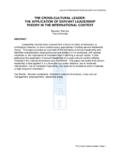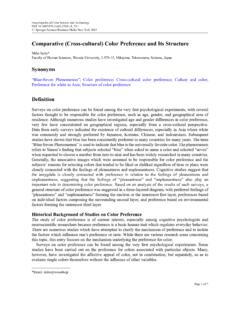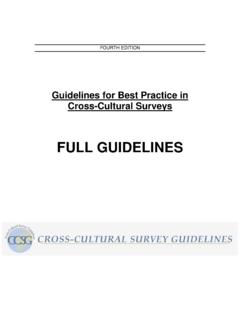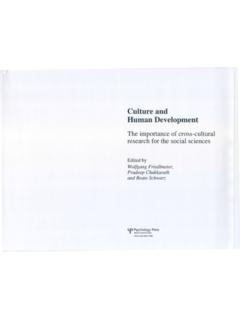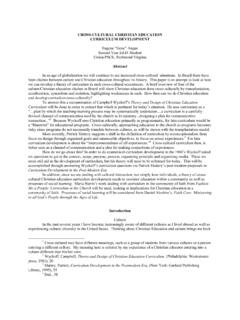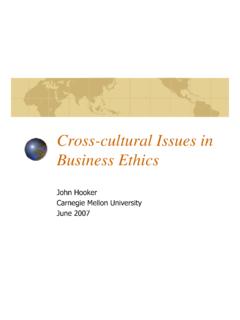Transcription of Cross-Cultural Competence: The Role of Emotion …
1 Cross-Cultural Competence: The Role of Emotion RegulationAbility and OptimismBianca C. Trejo and Erin M. RichardFlorida Institute of TechnologyMarinus van Driel andDaniel P. McDonaldDefense Equal Opportunity Management Institute,Patrick Air Force Base, FloridaCross- cultural competence (3C) is critical for military personnel to understand andperform effectively in complex cultural environments and to interact with individualsfrom other cultures. The knowledge, skills, and abilities that make up 3C can result inclearer communication, build trust, and strengthen relationships in Cross-Cultural socialcontexts (Selmeski, 2009). This research investigated the role of emotional regulationand optimism in the development of 3C in military personnel.
2 Results demonstrate thatthe ability to regulate emotions is positively related to 3C, both directly and through itseffect on : emotions , Emotion regulation, Cross-Cultural competency, optimismSupplemental materials: researchers and practitioners haveincreased their focus on Cross-Cultural compe-tence (herein referred to as 3C) because of theneed for conflict resolution, nation-building,and peacekeeping operations around the has been defined as the knowledge, skills,abilities, and other characteristics that enablelearning and adapting to unfamiliar cultures(Abbe, Gulick, & Herman, 2008). These com-petencies are particularly important for militarypersonnel who interact with host nationals andmust adapt across cultural lines.
3 3C encom-passes the communication and interpersonalskills that are essential to thrive in culturallydiverse contexts. These skills are vital to mis-sion operations because they often prove criticalfor compliance-gaining, relationship-building,and information transfer (Ruben, 1989) as wellas securing intelligence and achieving primary purpose of the current researchis to examine the role of Emotion regulationability and optimism in the development of researchers have called for greater at-tention to the role of affect in determining 3C(Matsumoto, 2009;Matsumoto & Juang, 2004;Reid, 2010;Tan, Hartel, Panipucci, & Stry-bosch, 2005;Yoo, Matsumoto, & LeRoux,2006).
4 Communication difficulties, misconcep-tions, deep-seated beliefs, and general uncer-tainty make the experience of strong Emotion acommon occurrence in Cross-Cultural , the ability to regulate such emotionand maintain positive attitudes is key to Cross-Cultural effectiveness. Emotion regulation is vi-tal to interact with others, communicate effec-tively, and manage stress (Keltner & Haidt,2001;Lopes, Salovey, Cote & Beers, 2005), allof which are key requirements in cross -culturalwork CompetenceAlthough 3C is a fairly new concept, numer-ous models have been proposed. Excellent re-views of these models can be found inJohnson,This article was published Online First July 27, C.
5 Trejo and Erin M. Richard, Department ofPsychology, Florida Institute of Technology; Marinus vanDriel and Daniel P. McDonald, Defense Equal OpportunityManagement Institute, Patrick Air Force Base, C. Trejo is now at the Consumer Insight, TheWalt Disney Company, Kissimmee, Florida and Marinusvan Driel is now at the Accenture Strategy, Accenture,Atlanta, concerning this article should be ad-dressed to Erin M. Richard, Department of Psychology,Florida Institute of Technology, 150 West University Bou-levard, Melbourne, FL 32901. document is copyrighted by the American Psychological Association or one of its allied article is intended solely for the personal use of the individual user and is not to be disseminated Psychology 2015 American Psychological Association2015, Vol.
6 27, No. 5, 276 2860899-5605/15/$ , and Apud (2006)and Mendenhall,Osland, Bird, Oddou, and Maznevski (2008).There have also been numerous studies investi-gating 3C in the military setting (Laurence,2011;Russell, Crafts, & Brooks, 1995; Selm-eski, 2009). Nevertheless, a limitation of mostprevious models of 3C is that they include sev-eral variables that could be argued to be ante-cedents of 3C ( , empathy, Emotion regula-tion, need for closure). Indeed, one of thedifficulties facing researchers in this area is theambiguity involved in classifying a variable asan antecedent of 3C versus part of the constructitself (Campbell, Gasser, & Oswald, 1996;Dinges, 1983;Klemp, 1979).
7 Recent task-analysis-based models of 3C ( ,Johnston,Paris, McCoy, Severe, & Hughes, 2010; Mc-Closkey, 2008;McCloskey, Grandjean, & Be-hymer, 2009) help resolve this debate by focus-ing on specific behavioral examples of effectiveperformance in Cross-Cultural environments. Atask analysis uses subject matter experts(SMEs) to determine the knowledge, skills,abilities, and other characteristics that are essen-tial to job performance. Task analysis oftenincludes the identification of critical incidents,or specific behavioral examples of the differentlevels of job performance (Goldstein & Ford,2002). By keeping the focus on behavior, atask-analysis-based approach helps researchersseparate the proximal, performance-based as-pects of 3C from the more distal antecedents( , personal characteristics) of and colleagues (McCloskey,2008;McCloskey et al.)
8 , 2009) developed amodel of 3C using this approach. They con-ducted 50 interviews with military SMEs whohad been deployed overseas, asking about theirmajor job components during deployment andthe most challenging aspects of such compo-nents. The current research is based on a modelcalled the Framework (Johnston et al., 2010),which built onMcCloskey et al. s (2009) et al. (2010)presented groups ofSMEs with a list of competencies based onMcCloskey et al. s (2009)task analysis andother previous research ( ,McDonald,McGuire, Johnston, Selmeski, & Abbe, 2008)coupled with feedback and recommendationsfrom the Defense Language Office RegionalProficiency Assessment Project (seeNaval AirWarfare Center Training Systems Divisions,2010).
9 Johnston et al. (2010)integrated thisinformation to produce a final set of core com-petencies, core enablers (antecedents), andlearning recommendations. A key strength ofJohnston et al. s (2010)model is that it makes aclear distinction between personal characteris-tics and attitudes (considered antecedent to 3C)and the actual behavioral competencies neces-sary for Cross-Cultural effectiveness. However,despite its substantial content validity, littleempirical research has been performed on Framework identifies two broad catego-ries of core competencies: Thinking and Con-necting. Thinking competencies include culturalknowledge, organizational awareness, and cul-tural knowledgere-fers to awareness of the values, social interac-tion norms, and religious beliefs of differentcultures (van Dyne, 2005).
10 Such knowledgethen guides individuals behavior in Cross-Cultural awarenessisthe extent to which individuals understand andapply information about the organization s mis-sion and functions ( , programs, policies,procedures) (Wisecarver, Ferro, & Hope, 2010).It includes familiarity with conflict resolutionnorms within and outside of the organizationand the ability to interpret the social, political,and technological systems at work in the perspective-taking skillsin-volve observing and interpreting the relevancyof situational or environmental cues while tak-ing cultural context into account (McCloskey etal., 2009;Wisecarver et al., 2010). Individualswith perspective-taking skills detect, analyze,and consider others points of view, and theyunderstand how culture influences self-percep-tion, perception of others, and behavior (John-ston et al.)










